



Meeting the Nutrient Requirements of Broiler Breeders
In his Tech Info 9 article for Canadian Poultry Industry Council, Dr John D. Summers examines what is known about the nutrient requirements of broiler breeders, and applies that to practical feeding practices.Major changes have taken place with the feeding of broiler breeders in recent years. One of the most significant of these changes was separate sex feeding. With such an approach to feeding it is now possible to more closely control the weight of the pullet coming into production and to be confident that, with challenge feeding, the additional feed is being used to maximize egg output rather than put extra weight on already overweight cockerels. By being able to precisely control cockerel weight, marked improvements in hatch of total eggs set, with reduced cockerel numbers, is being attained.
With separate sex feeding, changes in ration formulation to more precisely meet nutrient requirements of males and females are now possible. Also more attention can now be paid to flock uniformity and by switching to everyday feeding, uniform pullet flocks that reach peak production in 4 to 5 weeks, and produce 180 to 190 eggs per breeder, is not uncommon.
While there are many points to consider with respect to management, feeding, health care, photoperiod, etc., that can have a bearing on the economics of production, the present article will deal mainly with feeding to more precisely meet the energy and protein requirements of the modern day broiler breeder.
Body Weight and Condition:
While body weight recommendations are readily available for the various commercial breeders on the market today, often there is little information given on how to keep problem flocks close to these suggested weights. A 6 week old commercial female broiler will weigh around 1800g while a weight of 600g is the target weight for a broiler breeder pullet of the same age. Hence, it is evident that overweight, not underweight pullets are usually the problem during the growing period. Pullets that are overweight during rearing should not have their feed allotment reduced in order to bring their weight in line with suggested target weights. Rather, feed should be held at the same level until body weight comes in line with that recommended for a given age. Then adjustments in feed allowance should be made to hold pullets to the desired weight curve.
Another important point is to ensure that pullets, as they approach mature pullet weight, are carrying sufficient body flesh. This can be observed by checking fleshing over the keel. Pullets that are lacking in flesh are immature birds and will be delayed coming into production. Increase feed, if necessary, to ensure well fleshed pullets and delay light stimulation of the flock until proper body condition has been achieved, even though body weight may be slightly in excess of the weight guide.
Nutrient Requirements:
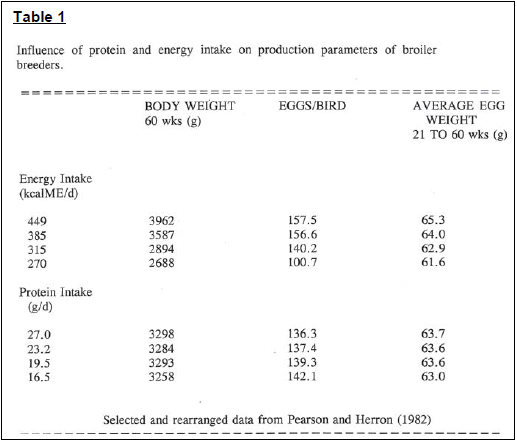
Two of the major and most costly nutrients required by the breeder are energy and protein. While protein requirements have often been the major consideration of most producers, usually it is energy, the most costly dietary nutrient, which has the most influence on performance. This is demonstrated in Table 1 where varying energy intake by approximately 40%, had a marked effect on production parameters, while a similar change in protein intake had little effect on performance.
Energy:
Energy is often referred to as “The Fire of Life”. Feed supplies energy, which in turn is required for growth, egg production, maintenance, vital life functions and activity. In developing feeding programs for broiler breeders consideration should be given to body size, as this is a major factor, along with environmental temperature, influencing the maintenance energy requirement. Production of a product is the other major consideration. This may include a growth component but the main consideration is egg mass output.
Maintenance:
The maintenance energy requirement is affected by body size, environmental temperature and level of activity. In order to calculate energy requirements a knowledge of the calorie requirement per unit body size (surface area), growth rate, and egg mass output must be known. Environmental temperature must also be taken into account as it will affect the energy needs for maintenance. This is important for as will be discussed, the energy requirement for maintenance makes up by far the greatest percentage of the birds total energy requirement. A number of equations have been developed which give reasonable estimates of the total energy requirement of a broiler breeder. However, as with any predicted estimate, such values must be evaluated for each and every situation.
Energy Requirements for Pullets:
In Table 2 is shown the predicted energy requirements for broiler breeder pullets to 20 weeks of age. As the bird increases in age (larger body size) the maintenance energy requirement increases as a percentage of the total energy requirement until, by the later part of the growing period, over 80% of the energy consumed is used just to maintain the pullet.
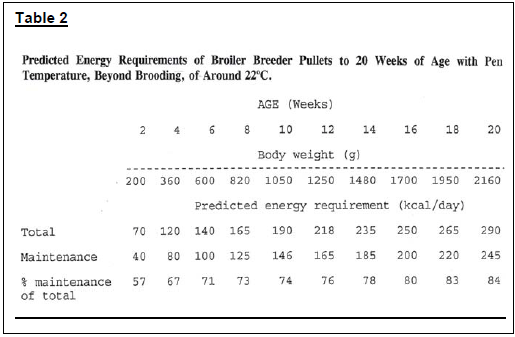
It is important that growers recognize that the major factor influencing feed intake is the bird’s need to meet it’s maintenance energy requirement. Since environmental temperature is the main factor influencing maintenance energy requirement (other than body weight), pen temperature should be closely monitored and feed intake adjusted accordingly if significant temperature changes result. While precise changes in feed allotment, to account for changes in environmental temperature, are difficult to predict accurately, a reasonable estimate would be that for every 1°C change in pen temperature through a temperature range of 15 to 30°C, the bird will alter its feed intake by 3g/d. However at high or low temperatures the change in feed intake would be significantly greater.
Energy Requirement for Broiler Breeders:
In Table 3 is shown the predicted energy requirements for broiler breeder hens from 20 to 68 weeks of age. Again it can be noted that the maintenance energy requirement is around 80% of total energy intake. This decreases noticeably at peak production and continues to peak egg mass when the hen would be partitioning a significant proportion of its’ energy intake to meet its requirement for egg mass output.
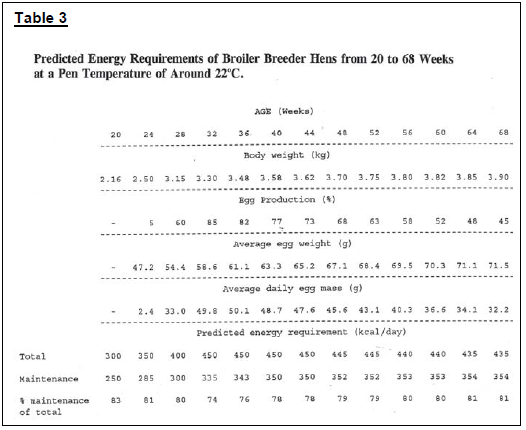
Again if one is to precisely meet the breeder’s energy requirement, factors influencing this requirement must be considered. One is the increase in body weight and this is apparent by the steady increase in maintenance energy requirement as the production cycle progresses (Table 3). However, total energy requirement peaks around peak egg mass production and then declines as the requirement for egg mass production is reduced as egg production decreases. It is important that the producer recognize the fact that only around 20% of the energy intake of the hen is diverted into egg production and increased body weight (which would be fairly small). Since the hen will preferentially partition nutrients to meet her requirement for maintenance, if her feed allowance is not sufficient to meet her total energy requirement, egg mass output and thus egg production and/or egg size will be reduced.
Influence of Feather Condition or Energy Requirements:
While pen temperature has a significant effect on maintenance energy requirement, the feather condition of the hen can significantly influence the affect of environmental temperature. In Table 4 is shown the influence of feather cover on predicted energy requirements of a breeder at two different environmental temperatures. A marked increase in feed intake is noted with birds as they lose feathers, which often occurs with aging as well as poorly managed flocks. Allowance must be made for feather condition when estimating the calorie needs of a flock if maximum production and egg size are to be maintained.

Reducing Feed Intake Past Peak Production:
It is common practice to reduce feed allowance to a flock shortly after peak production is attained. This may be responsible for some of the dips in production noted shortly after peak is attained. As can be noted in Table 3, peak egg mass output is not attained until several weeks after peak egg production, (eg.) if production drops 5%, feed allowance is reduced for a flock until at least 4 to 5 weeks after peak production has been reached.
Another error that a number of producers make is to reduce feed allowance in relation to the drop in egg production, (eg.) if production drops 5%, feed allowance is reduced by a similar amount.
An average egg of around 65g requires approximately 140kcal of metabolized energy for its production. If feed allowance is 160g/b/d at peak production, with a diet containing 2800 kcal/kg, this will result in a daily intake of 448 kcal ME/b/d. If 140 kcal are required for the production of one egg this means that approximately 31% of the hen’s energy intake is going towards egg production at this time. Egg mass output at 85% production and with a 65g egg = 55.3 g/h/d. If production drops to 80%, and during this time egg weights increases by 1g, egg mass output would be 52.8g/h/d. Thus egg mass output would drop;
55.3 ÷ 52.8 X 100 = 4.5%
55.3
Hence, the energy required per hen per day for egg production should drop;
4.5 X 140 = 6.3 kcal
100
Thus for a 4.5% drop in egg mass output total dietary energy requirement has only dropped
6.3 X 100 = 1.4%
448
…(not the 5% that one might estimate from the drop in egg production). It should be obvious that decreased feed intake after peak production has to be precisely calculated as the hen’s requirement is not related directly to the drop in egg mass output. From the above discussion it should be apparent that there is a strong possibility that the broiler breeder is deficient in energy intake up to and perhaps beyond peak egg mass production. As already mentioned any deficiency in energy intake will readily translate into reduced egg numbers or smaller eggs or both.
In Table 5 an estimate of the energy intake per day is shown with various feed intakes and diets of different energy concentration.
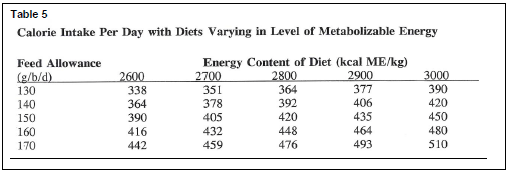
Protein:
Since the maintenance requirement for energy is so high, in relation to the breeders total energy requirement, energy intake is one of the main factors influencing the reproductive performance of broiler breeders. Thus changes are often made in daily feed allotment in order to try and maintain an optimum intake of energy. However, little attention is paid to the amount of protein consumed by the hen. Most breeder diets contain between 16 and 18% protein. With variable feed intakes during the laying period, daily protein intake obviously varies. Many breeders are fed up to 160g of feed per day (or more). Thus protein intake could range from 25.6 to 28.8g per day, and in many cases higher).
Protein Required for Egg Production:
What is the calculated protein requirement for the broiler breeder? Using values generated for commercial layers, the protein required to produce a 65g egg (containing 7.8g of protein) should be around 7.8÷.55 (suggested efficiency of dietary protein utilization for egg production) = 14.2g.
Protein Required for Maintenance:
With an estimated total endogenous loss of nitrogen, including feather loss, to be 280 mg/kg of body weight to the 0.75 power, a 3.5kg hen would require 3.575 X 280 = 717mg of nitrogen per day to meet her maintenance requirement. Converting this to protein required would give (.717 X 6.25) or 4.48g of protein. Assuming the hen is 55% efficient in converting dietary protein to body proteins the hen would require 4.48 ÷ .55 = 8.15g of protein intake per day to meet her maintenance protein requirement.
Total Daily Protein Requirement of a Broiler Breeder
Considering egg production and maintenance the protein requirement would be 14.2 + 8.15 = 22.4g/h/d. This should be sufficient for a hen to lay a 65g egg every day. While no allowance has been made for body weight gain, this should be minimal after peak production and besides much of this gain will be fat deposition and thus a minimum of body protein would be deposited.
Since every bird in a flock is not laying an egg a day the protein required for egg production per day is only the average percent production times the estimated 14.2g of protein required for the 65g egg. Thus the daily protein required of a flock of broiler breeders would be significantly less than 22.4 g/b/d. While the above values are only estimates of protein requirements, they are reasonably good estimates based on values generated mainly from egg production hen values.
Partitioning the Breeders Protein Requirement:
While it was shown that around 80% of the energy consumed is partitioned to meeting the hens requirement for maintenance (including weight gain and activity) it can be estimated from the values generated for protein requirements that, (8.15 ÷ 14.2 X 100) approximately 57% of the protein intake of the breeder is going to meet its’ requirement for egg mass production. Thus the main factor influencing the protein requirement of the broiler breeder is egg mass output, not body maintenance as with energy.
Estimated Protein Requirements for Flock Breeders:
From Table 6 one can estimate protein requirements of the breeder at various stages of the egg production cycle assuming each hen is laying an egg a day. Thus to get a reasonable estimate of the average protein requirement per day by a flock of hens the values calculated from Table 6, should be reduced to take into account percent production (eg. egg mass output hen/d).

Percent Dietary Protein to Meet Requirements:
In Table 7 the estimated protein required for a flock of hens laying at 70% production with a calculated individual requirement ranging from 16 to 26 g/b/d would be from 11.2 to 18.2g respectively. This would translate into dietary protein levels of from 7 to 11.4% to meet these estimated requirements, assuming an average feed intake of 160g/b/d.
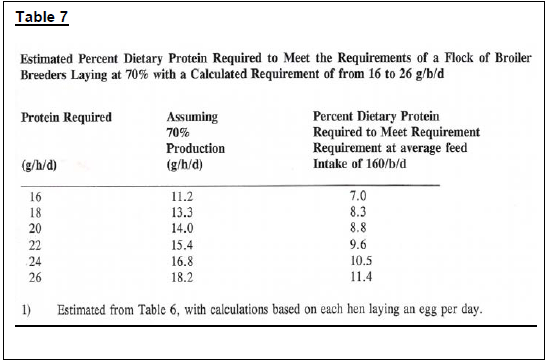
While a lot of assumptions and estimates have been made in generating the above values the low levels of dietary protein suggested are not too far removed from the estimates suggested by Bowmaker and Gous (1989), Harms and Ivey (1992) and Lopez and Leeson 1993).
As can be noted in (Fig. 1) 10% dietary protein resulted in comparable egg production from the report of Lopez and Leeson (1993) as compared to a 16% protein control diet. Indeed by the end of the trial, egg numbers produced were similar for both these treatments. However, based on the body weight curves (Fig. 2) 10% dietary protein was not high enough to maintain body weight at acceptable levels. As has been reported on numerous occasions with egg production type hens low dietary protein levels, while supporting good egg production usually result in smaller egg weights regardless of essential amino acid supplementation. From the data shown in (Fig. 3), this is also the case for broiler breeders.
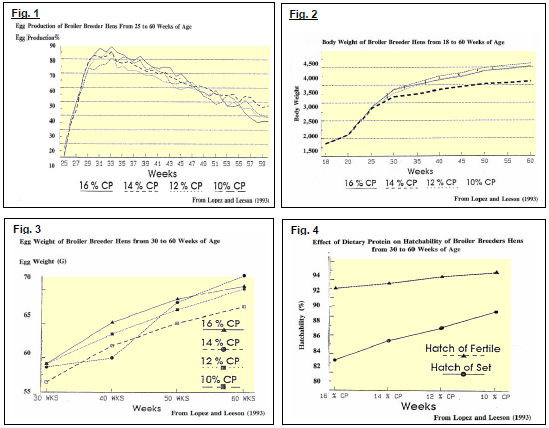
Lopez and Leeson (1993) also demonstrated and increase in hatchability with lower protein diets (Fig. 4). It is interesting to note the number of reports that have shown the detrimental effects of high protein intakes for broiler breeders, yet many in the industry still insist on feeding high protein breeder diets.
In Table 8 the data of Pearson and Herron (1982) show an increase in dead and deformed embryos, thus resulting in decreased hatchability of fertile eggs with 27 versus 23.1g of protein intake per bird per day. Similarly, Whitehead et al (1985) reported a significant increase in saleable chicks per breeder with a 13.7 versus a 16.8% protein breeder diet (Table 9).


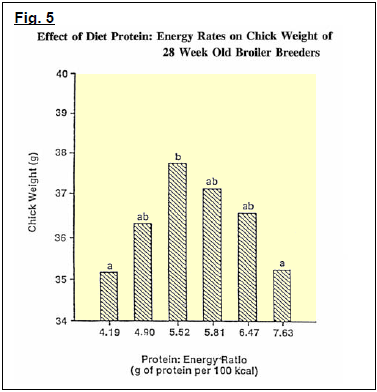
There appears to be a lot of evidence to suggest that most broiler breeders are being subjected to excessive intakes of dietary protein. Not only is such a practice detrimental to performance, but it is uneconomical as well as resulting in a greater potential pollution problem with higher levels of nitrogen in the litter from such flocks.
The argument is still heard that “I have to continually increase daily feed allowance in order to maximize egg production”, and/or “I had to increase dietary protein levels to increase egg number and size”. As has been clearly demonstrated the breeder’s main nutrient requirement is for energy and around 80% of this (under good management conditions) goes just to maintain the bird. If the hen’s intake of feed is not sufficient to meet her maintenance energy requirement, dietary protein will be preferentially burned for energy purposes. Hence, a level of dietary protein which should have readily met the hen’s total requirement is now deficient with respect to meeting the breeder’s requirement for egg mass production. If dietary protein is increased, with such a situation, often an increase in egg mass output is noted. Also if an increase in feed allowance is made a response in performance is usually also noted as more energy is available to meet energy requirements, thus leaving a greater amount of dietary protein to be utilized for egg mass output
What often happens is that dietary protein levels are increased to the point where protein is in excess of requirements and thus nitrogen excretion is increased. It requires a substantial amount of energy to synthesize and excrete uric acid, the nitrogen excretory product of birds. Thus, as dietary protein levels are increased, protein intake increases, uric acid excretion increases and the energy requirement of the bird significantly increases. With such a situation production responses are often noted with excessive allowances of feed. If a flock is not attaining expected egg numbers and size with a daily feed allowance of 150 to 160 g/b/d, one should take a critical look at possible management factors before changing diet composition or significantly increasing feed allowance. However, it must be remembered that some well managed uniform flocks are reaching production peaks of over 85% and maintaining good production longer than were flocks a few years ago. Such flocks may require more than the normally recommended level of feed allowance in order to meet their energy requirements. While it is true that as egg mass output increases and a larger percentage of protein intake is partitioned into egg production, one might question whether dietary protein level should be increased. However, with the increased intake of protein as feed allowance is increased, intake of dietary protein is seldom, if ever a problem with broiler breeders.
As mentioned previously there are many good production models available for estimating energy and protein requirements of breeders and in many cases these are considered by nutritionists. The intent of the present article was not to try and compete with the nutritionist regarding diet formulation, but rather to try and point out to producers avenues to pursue and reasons why they may not be achieving optimum performance from their flocks.
It is often stated that seldom is the diet at fault but rather it is the feeding program or the management conditions under which the diet is being fed which is the problem. This is especially true for broiler breeders where the nutrient intake and requirements of the birds is very much under the control of the flock manger.
Broiler breeders are fed to maximize the production of saleable chicks per bird. Considerations of some of the points raised in the present article might help some producers to increase this number.
References
Bowmaker J.E. and R.M Gous 1989. Quantification of reproductive changes and nutrient requirements of broiler breeder pullets at sexual maturity. British Poultry Sci. 30: 663-675.
Lopez G. and S. Leeson 1993. Low protein diets for broiler breeders. Poultry Digest September pp 34-37.
Harms R.H. and F.J. Ivey 1992. An evaluation of the protein and lyaine requirements for broiler breeder hens. Journal Applied Poultry Research 1: 308-314.
Pearson R.A. and K.M. Herron 1981. Effects of energy and protein allowances during lag on the reproductive performance of broiler breeder hens. British Poultry Sci. 22: 227-239.
Pearson R.A. and K.M. Herron 1982. Effects of maternal energy and protein intakes on the incidence of malformation and malpositions of the embryo and time of death during incubation. British Poultry Sci. 23 71-77.
Pearson R.A. and K.M. Herron 1982. Relationship between energy and protein intakes and laying characteristics in individual cage broiler breeder hens. British Poultry Sci. 23: 145-159.
Spratt R.S. and S. Leeson 1987. Broiler breeder performance in response to diet protein and energy. Poultry Sci. 66: 683-693.
Whitehead C.C., A. Pearson, K.M. Herron 1985. Protein requirements of broiler breeders fed diets of different protein content and effect of insufficient protein on the viability of progeny. British Poultry Sci. 26: 73-82.








